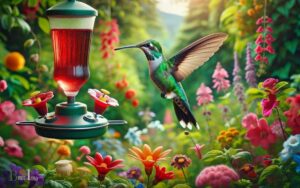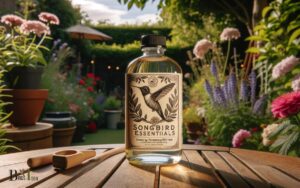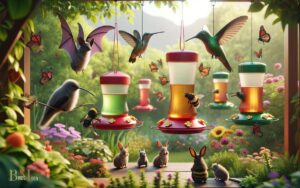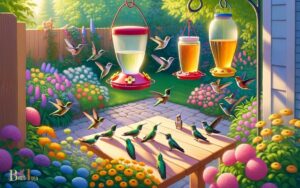What Is Drinking My Hummingbird Food at Night? Find Out!
The most common nocturnal visitors to hummingbird feeders include bats, raccoons, opossums, and various insects such as moths and ants.
These animals and insects are attracted to the sweet liquid and may consume it when the hummingbirds are not active.
Your hummingbird feeder can attract a variety of nighttime creatures:
Each of these animals has its own reasons and methods for accessing the nectar, posing different challenges for those wishing to deter them.
Safeguard your hummingbird feeder with strategic placement and protective measures to deter nocturnal nectar-lovers.
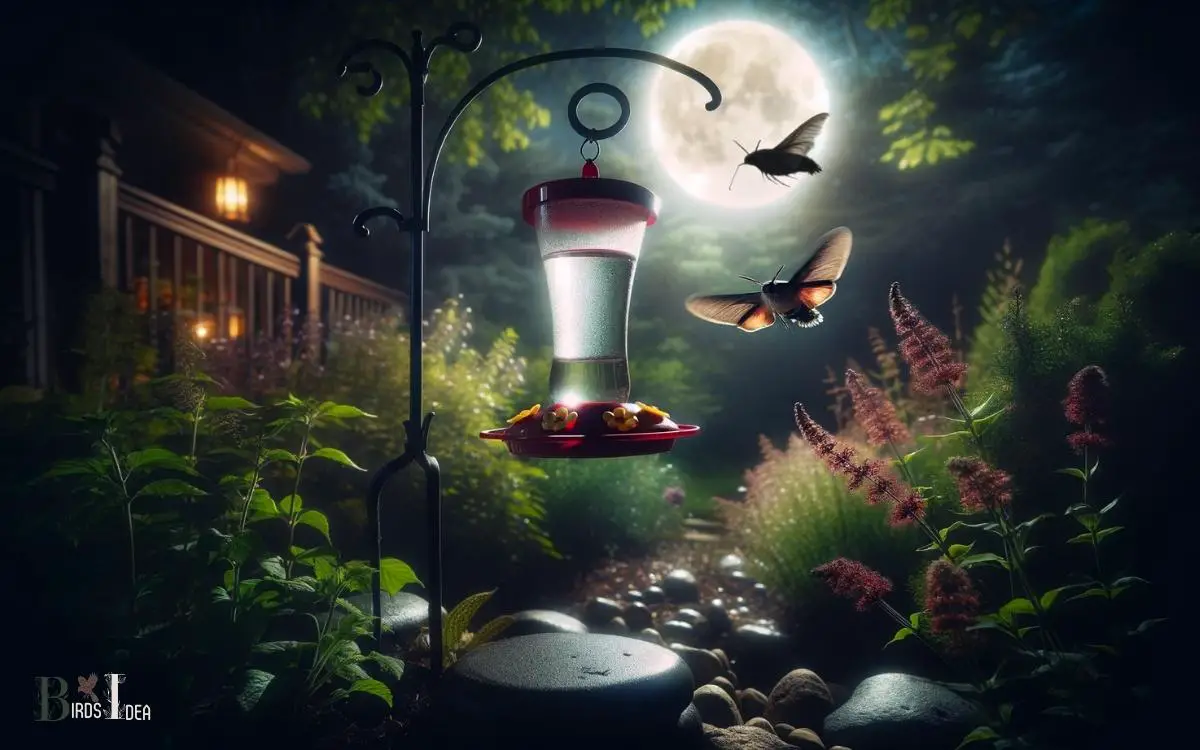
Key Takeaway
Nocturnal Animals
Some nocturnal animals may be responsible for consuming hummingbird food at night. Creatures such as raccoons, opossums, and bats are known to be active during the late hours and could potentially feed on the sweet nectar meant for hummingbirds.
These animals have a keen sense of smell and are attracted to sugary substances, making them likely culprits for the disappearance of hummingbird food.
To prevent nocturnal animals from accessing the feeders, consider bringing them indoors at night or installing baffles and barriers that make it difficult for these creatures to reach the food.
By taking these measures, you can ensure that the hummingbirds receive the nourishment they need without interference from nocturnal visitors.
Insects and Bugs
As we explore the mystery of what is consuming hummingbird food at night, it’s important to consider the role that insects and bugs might play in this scenario.
Noisy nighttime bug activity could be a potential indicator of their presence around the feeding stations.
Furthermore, insects are naturally attracted to nectar, which could explain their interest in the hummingbird food.
Preventing bug infestations around the feeders is essential to ensure the food remains available for the intended visitors.
Noisy Nighttime Bug Activity
During the night, hummingbird feeders may attract noisy nighttime bug activity, as insects and bugs are drawn to the sweet nectar.
The buzzing and fluttering of these insects can disrupt the peaceful ambiance of the garden, potentially causing concern for those who enjoy serving others and providing a tranquil environment.
Common culprits include moths, beetles, ants, and even mosquitoes, all of which are attracted to the sugary concentration of the hummingbird food.
To mitigate this issue, it is advisable to clean the feeders regularly, ensuring that there are no spills or leaks that could attract bugs. Additionally, positioning the feeders in well-lit areas can help deter nighttime bug activity.
By addressing this concern, one can create a more serene and enjoyable environment for both hummingbirds and those who appreciate their presence.
Insect Attraction to Nectar
In the presence of sweet nectar, insects and bugs are drawn to hummingbird feeders, posing a potential disruption to the peaceful ambiance of the garden.
These insects and bugs are attracted to the sugary liquid in the feeders due to their natural inclination towards sweet substances.
This can lead to an influx of unwanted pests around the feeders and may deter hummingbirds from feeding.
The most common insects and bugs attracted to nectar include ants, bees, wasps, and even some species of flies.
These pests can not only consume the nectar but can also create a nuisance for both the hummingbirds and the garden enthusiasts.
To prevent bug infestations and maintain a harmonious environment for the hummingbirds, it is crucial to implement effective strategies for deterring insects from the nectar feeders.
Preventing Bug Infestations
To maintain an environment conducive to hummingbird feeding, it is essential to implement effective strategies for deterring insects from the nectar feeders, which are drawn to the sweet nectar due to their natural inclination towards sweet substances.
To prevent bug infestations in hummingbird feeders, consider using feeders with bee guards or built-in ant moats, which can help prevent insects from accessing the nectar.
Additionally, regularly clean the feeders with a solution of hot water and vinegar to remove any residue that may attract bugs.
Positioning the feeders in shaded areas can also help as direct sunlight can cause the nectar to ferment more quickly, attracting insects.
Lastly, consider using nectar with added natural deterrents like lemongrass or clove oils to discourage insect infestations while still attracting hummingbirds.
Other Bird Species
At night, other bird species may consume the hummingbird food, competing for the available nectar. This can be a common occurrence, especially in areas where multiple bird species coexist.
Some of the other bird species that may be consuming the hummingbird food at night include:
- Orioles
- Warblers
- Thrushes
These birds are known to be attracted to sugary nectar, and their nighttime visits can deplete the food intended for the hummingbirds.
To address this issue, it’s important to consider introducing deterrents or adjusting feeding schedules to minimize competition and ensure that the hummingbirds have access to the food they need.
Transitioning into the subsequent section about ‘rodents and small mammals’, it’s also crucial to consider the potential impact of these animals on the hummingbird food source.
Rodents and Small Mammals
Nighttime visits by other bird species can create competition for the available nectar, and this can also be true for rodents and small mammals.
Rodents like mice and rats, as well as small mammals such as squirrels and bats, are attracted to the sweet scent of hummingbird food.
They may consume the nectar directly from the feeder, causing a depletion of the food meant for the hummingbirds.
To mitigate this issue, consider using rodent-proof feeders that are designed to prevent access by these animals.
Additionally, placing the feeders in open areas away from overhanging branches or structures can also deter rodents and small mammals from reaching the nectar.
Regularly cleaning up any spilled nectar and using deterrents like capsaicin or peppermint oil can further discourage these animals from consuming the hummingbird food.
Environmental Factors
As we consider the nighttime activity around hummingbird feeders, it’s important to explore the influence of environmental factors.
Nocturnal wildlife activity, the impact of outdoor lighting, and the effects of weather and temperature are all key aspects to consider.
Understanding how these factors interact can provide valuable insights into what may be drinking hummingbird food at night.
Nocturnal Wildlife Activity
Nocturnal wildlife activity plays a significant role in determining what creatures may be consuming hummingbird food during the nighttime. Understanding the behaviors of nocturnal animals can help identify potential culprits.
- Raccoons: These opportunistic foragers are known to raid bird feeders and may also be attracted to the sweet nectar in hummingbird feeders.
- Bats: Some bat species are known to feed on nectar, and they are active during the night, making them potential consumers of hummingbird food.
- Opossums: These omnivorous creatures are active at night and may investigate hummingbird feeders for food.
These nocturnal creatures, among others, can be attracted to the sugary content of hummingbird food.
Understanding their behaviors and dietary preferences is essential in identifying the nighttime visitors to hummingbird feeders.
The impact of outdoor lighting on these nocturnal wildlife activities will be discussed next.
Impact of Outdoor Lighting
During the evening hours, outdoor lighting can significantly influence the behaviors and interactions of nocturnal wildlife, potentially affecting their consumption of hummingbird food.
The artificial illumination can disrupt natural light patterns, leading to several impacts on the environment.
Here are some of the key ways outdoor lighting can affect nocturnal wildlife:
| Impact of Outdoor Lighting | Description |
|---|---|
| Disrupted foraging behavior | Nocturnal animals may alter their foraging patterns and locations due to the presence of artificial light. This can lead to changes in their feeding habits, potentially affecting their consumption of resources such as hummingbird food. |
| Altered sleep patterns | Artificial light at night can disrupt the natural sleep-wake cycles of nocturnal wildlife, leading to changes in their overall activity levels and energy expenditure. |
| Increased predation risk | Outdoor lighting can attract predators to illuminated areas, potentially exposing nocturnal wildlife to higher predation risk while they consume food or engage in other activities. |
Can Other Animals Drink Hummingbird Food at Night?
Intriguingly, hummingbirds have a unique method of feeding called “how hummingbirds drink.” However, when it comes to other animals, accessing their food is a different story. Most animals are unable to consume hummingbird food at night, as the tiny birds’ rapid feeding pace and specialized beaks make it challenging for others to compete.
Solutions and Preventive Measures
In considering solutions and preventive measures for protecting hummingbird feeders, it is essential to address potential issues related to feeder design and placement.
To safeguard the hummingbird feeders and ensure the well-being of these delicate creatures, the following steps can be taken:
- Install a baffle or ant moat to prevent access by nocturnal animals.
- Use a hanging mechanism that is difficult for larger animals to reach.
- Place the feeder in a well-lit area or consider using a motion-activated light to deter nighttime pests.
Implementing these measures will help to protect the hummingbird feeders from unwanted visitors and ensure that the nectar is available for the intended recipients.
By taking proactive steps, it is possible to create a safe and inviting environment for these beautiful birds.
Conclusion
The nocturnal animals, insects and bugs, other bird species, and rodents and small mammals are all potential culprits for drinking hummingbird food at night.
Environmental factors and feeder design and placement may also play a role in attracting these creatures.
To prevent this, it is important to consider these factors and take preventive measures such as using deterrents and securing the feeder properly.

